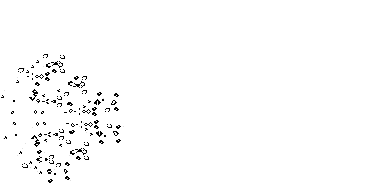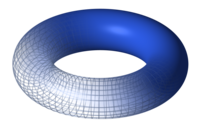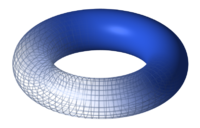A cellular automaton (plural: cellular automata) is a discrete model studied in computability theory, mathematics, theoretical biology and microstructure modeling. It consists of a regular grid of cells, each in one of a finite number of states. The grid can be in any finite number of dimensions. Time is also discrete, and the state of a cell at time t is a function of the states of a finite number of cells (called its neighborhood) at time t − 1. These neighbors are a selection of cells relative to the specified cell, and do not change (though the cell itself may be in its neighborhood, it is not usually considered a neighbor). Every cell has the same rule for updating, based on the values in this neighbourhood. Each time the rules are applied to the whole grid a new generation is created.

One way to simulate a two-dimensional cellular automaton is with an infinite sheet of graph paper along with a set of rules for the cells to follow. Each square is called a "cell" and each cell has two possible states, black and white. The "neighbors" of a cell are the 8 squares touching it. For such a cell and its neighbors, there are 512 (= 29) possible patterns. For each of the 512 possible patterns, the rule table would state whether the center cell will be black or white on the next time interval. Conway's Game of Life is a popular version of this model. It is usually assumed that every cell in the universe starts in the same state, except for a finite number of cells in other states, often called a configuration. More generally, it is sometimes assumed that the universe starts out covered with a periodic pattern, and only a finite number of cells violate that pattern. The latter assumption is common in one-dimensional cellular automata. 
A torus, a toroidal shape. Cellular automata are often simulated on a finite grid rather than an infinite one. In two dimensions, the universe would be a rectangle instead of an infinite plane. The obvious problem with finite grids is how to handle the cells on the edges. How they are handled will affect the values of all the cells in the grid. One possible method is to allow the values in those cells to remain constant. Another method is to define neighbourhoods differently for these cells. One could say that they have fewer neighbours, but then one would also have to define new rules for the cells located on the edges. These cells are usually handled with a toroidal arrangement: when one goes off the top, one comes in at the corresponding position on the bottom, and when one goes off the left, one comes in on the right. (This essentially simulates an infinite periodic tiling, and in the field of partial differential equations is sometimes referred to as periodic boundary conditions.) This can be visualized as taping the left and right edges of the rectangle to form a tube, then taping the top and bottom edges of the tube to form a torus (doughnut shape). Universes of other dimensions are handled similarly. This is done in order to solve boundary problems with neighborhoods. For example, in a 1-dimensional cellular automaton like the examples below, the neighborhood of a cell xit—where t is the time step (vertical), and i is the index (horizontal) in one generation—is {xi−1t−1, xit−1, xi+1t−1}. There will obviously be problems when a neighbourhood on a left border references its upper left cell, which is not in the cellular space, as part of its neighborhood.  |
History Stanisław Ulam, while working at the Los Alamos National Laboratory in the 1940s, studied the growth of crystals, using a simple lattice network as his model. At the same time, John von Neumann, Ulam's colleague at Los Alamos, was working on the problem of self-replicating systems. Von Neumann's initial design was founded upon the notion of one robot building another robot. This design is known as the kinematic model. As he developed this design, von Neumann came to realize the great difficulty of building a self-replicating robot, and of the great cost in providing the robot with a "sea of parts" from which to build its replicant. Ulam suggested that von Neumann develop his design around a mathematical abstraction, such as the one Ulam used to study crystal growth. Thus was born the first system of cellular automata. Like Ulam's lattice network, von Neumann's cellular automata are two-dimensional, with his self-replicator implemented algorithmically. The result was a universal copier and constructor working within a CA with a small neighborhood (only those cells that touch are neighbors; for von Neumann's cellular automata, only orthogonal cells), and with 29 states per cell. Von Neumann gave an existence proof that a particular pattern would make endless copies of itself within the given cellular universe. This design is known as the tessellation model, and is called a von Neumann universal constructor. In the 1970s a two-state, two-dimensional cellular automaton named Game of Life became very widely known, particularly among the early computing community. Invented by John Conway, and popularized by Martin Gardner in a Scientific American article, its rules are as follows: If a black cell has 2 or 3 black neighbors, it stays black. If a black cell has less than 2 or more than 3 black neighbors it becomes white. If a white cell has 3 black neighbors, it becomes black. Despite its simplicity, the system achieves an impressive diversity of behavior, fluctuating between apparent randomness and order. One of the most apparent features of the Game of Life is the frequent occurrence of gliders, arrangements of cells that essentially move themselves across the grid. It is possible to arrange the automaton so that the gliders interact to perform computations, and after much effort it has been shown that the Game of Life can emulate a universal Turing machine. Possibly because it was viewed as a largely recreational topic, little follow-up work was done outside of investigating the particularities of the Game of Life and a few related rules.
|